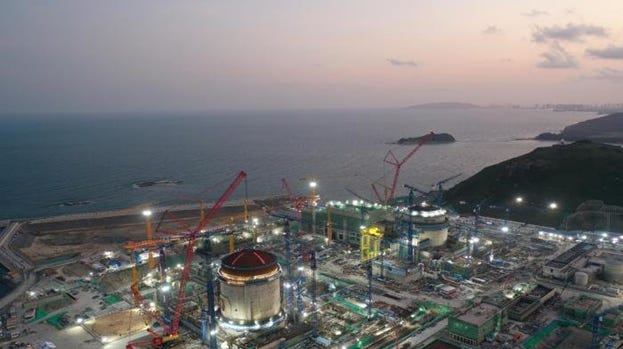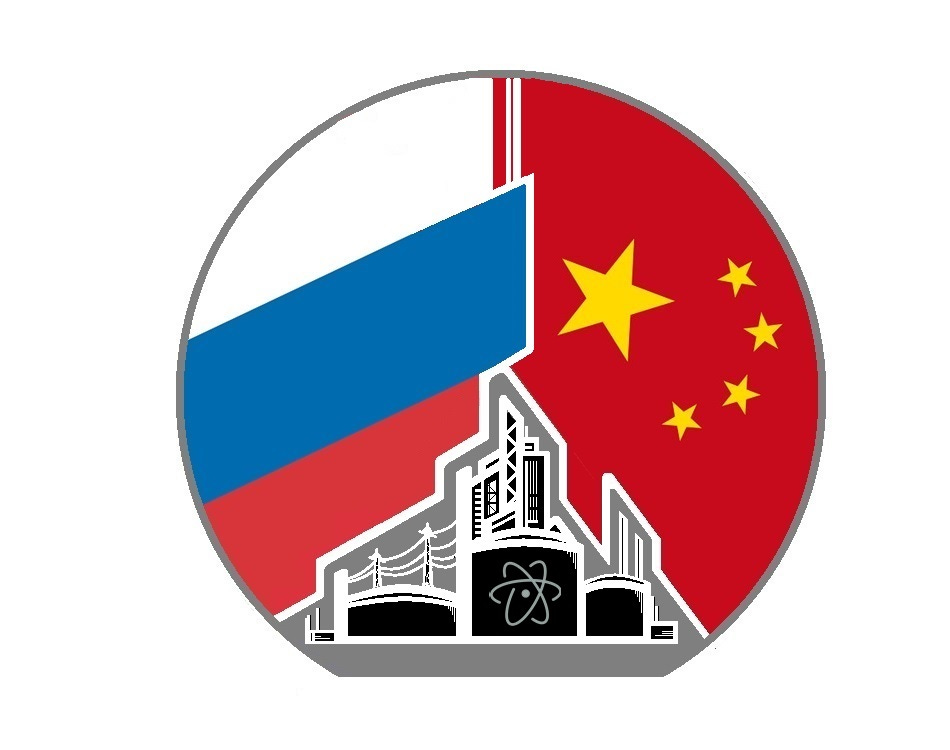Russian fuel for Chinese fast reactor, dome installation, Rosatom project updates
Russia/China Nuclear Energy Digest #2
In this issue…
Rosatom has shipped out the first batch of fuel for China’s CFR-600 demonstration fast reactor. What is the backstory of cooperation on the project?
The installation of a 225-ton dome on unit 2 of China’s Taipingling Nuclear Power Plant marks a major step forward in the construction of yet another domestic Hualong One reactor
Rosatom’s overseas projects in Hungary, Egypt, and Turkey move ahead, sanctions notwithstanding
Rosatom Provides Fuel for Chinese Fast Reactor, Backstory
Rosatom’s fuel subsidiary TVEL has dispatched the first batch of uranium fuel for China’s CFR-600 demonstration fast reactor (实验快堆/демонстрационный реактор на быстрых нейтронах) in Xiapu, Fujian Province. The fuel was fabricated in Electrostal on the outskirts of Moscow at facilities that were modernized last year. Two more shipments are expected before January for the initial load and first refueling of the reactor core.
Fast reactors differ from most power reactors currently in commercial operation as they rely on fast neutrons rather than thermal neutrons to create fission reactions. Capable of breeding fissile material from nuclear waste, fast reactors are envisioned as a crucial means of closing the nuclear fuel cycle and ensuring the future viability of nuclear energy.
The most recent dispatch of fuel for the CFR-600 was announced just three weeks after a landmark event for Russia’s own fast reactor development. On September 9, the BN-800 fast reactor unit at the Beloyarsk NPP was declared to have begun operating entirely on mixed-oxide, or MOX, fuel (混合氧化物核燃料/MOX燃料/МОКС топливо), fabricated from a mixture of depleted uranium and plutonium extracted from irradiated thermal reactor fuel. Both are byproducts of the existing nuclear fuel cycle.
China has officially announced a “three-step strategy” for the development and commercialization of nuclear energy technologies, progressing from thermal reactors to fast reactors and finally to fusion devices (热中子反应堆—快中子反应堆—受控核聚变堆“三步走”). The three tracks are being pursued simultaneously. Within the fast reactor development track, the plan has been to commercialize the technology after building a series of experimental and demonstration units. Although China succeeded in building a zero-power experimental fast reactor as early as 1969 after basic physics- and materials-related research, it was only in 1992 that the State Council approved the construction of a 65MWt/20MWe experimental fast reactor unit as part of the 863 Program aimed at advanced technology development. The sodium-cooled unit, named the CEFR, was eventually built on the outskirts of Beijing and achieved criticality in July, 2010.
Russia has been China’s partner in the development of fast reactor technology since the beginning of the CEFR project in the early 1990s, providing crucial technical assistance. In 2000, the two countries signed an intergovernmental agreement according to which Russia agreed to assist China in the design of the reactor, supply key equipment and fuel, advise startup and operation, and train Chinese operators at Russia’s own existing fast reactors. Although the envisioned startup date of 2003 was missed by a long shot, cooperation backed by the two governments was broadly successful.
As China prepared to construct a larger-capacity demonstration fast reactor, Russia offered to provide two units of its own BN-800 – the same fast reactor model that is now operating at Beloyarsk. A contract on pre-design studies was signed during then Prime Minister Vladimir Putin’s visit to China in 2009. Then the deal fell through, possibly over technology transfer and intellectual property rights, and China began to design its own CFR-600. The construction of the first unit started in 2017, and the second in 2020.
The fact that China went with its own fast reactor design did not mean the abandonment of cooperation with Russia. On June 8, 2018, the two countries signed an intergovernmental agreement to cooperate on the CFR-600 whereby Russia agreed to supply key equipment as well as uranium and MOX fuel. Both types of fuel can be loaded into China’s fast reactors, although so far only uranium fuel has been supplied. The Electrostal plant, in addition to fabricating fuel assemblies for the CEFR and the CFR-600, also supplies Russia’s own BN-600. The Russian MOX-fuel fabrication facility that supplies the BN-800, on the other hand, is located in Zheleznogorsk in the Krasnoyarsk region.
Significantly, the June 8, 2018 intergovernmental agreement on fast reactor cooperation contains a provision by which Russia is to offer China equipment and technical support for the latter to build its own MOX fuel fabrication facility. On June 3, 2018, a week before the signing of the agreement, China began constructing a CFR-600 MOX fuel fabrication plant in Gansu that was expected to start operating by 2025. The plant reportedly will have a capacity of 20 MT/year – exactly the amount Chinese sources say is needed to operate the CFR-600.
CFR-600 fuel rods | Source: Rosatom
Dome Installation Complete at Taipingling Unit 2
China General Nuclear (CGN) has successfully installed the dome of the second reactor unit at the Taipingling Nuclear Power Plant in Guangdong Province. The installation was completed at 7pm local time on September 25. Measuring 45 meters in diameter and weighing 225 tons, the dome would seal the reactor building and contain radioactive leakage in the event of an accident. The entire installation process was livestreamed on Chinese social media, showing the dome being hoisted to a height of around 70 meters before being lowered into place.
The Taipingling NPP is the first in the Guangdong-Hong Kong-Macao Greater Bay Area to utilize the indigenously designed Hualong One third-generation reactor. A total of six Hualong One units are planned there. The construction of unit 1 began in 2019, and unit 2 in 2020. Both are being built on schedule. Whereas the first unit has 90% local equipment, the second unit will have 95%, according to CGN representatives. Compared to Western third-generation PWRs like the AP1000 and EPR, the Hualong One is significantly easier and cheaper to build. The average unit takes only five years to complete and has a per kilowatt construction cost of less than $2,300 according to current exchange rates.
Dome installation at the Taipingling NPP | Source: China News
Updates on Rosatom’s Overseas Projects – Paks-2, El Dabaa, Akkuyu
Rosatom Director General Alexei Likhachev and Hungarian Foreign Minister Péter Szijjártó met on September 26 in Vienna, where they reaffirmed their commitment to finishing the Paks-2 project and discussed “further steps” allowing construction to proceed on schedule. Despite recent geopolitical complications and sanctions-related obstacles, Hungary has insisted on continuing its cooperation with Russia over Paks-2, even drawing a “red line” categorically opposing sanctions in the nuclear energy sector. Such sanctions, Budapest argues, would undermine Hungary’s ability to reduce dependence on volatile fossil fuels while infringing on its “sovereign right” to determine its own energy mix.
Launched in 2014, the Paks-2 project involves the construction of two Russian-designed VVER-1200 reactor units at the Paks NPP in Hungary, where four Soviet-designed VVER-440 units are already in operation. Civil construction and equipment manufacturing for the new units have already started following the issuance of construction permits in August. The training of technical specialists has also begun. On September 30, Rosatom reported delivering preparatory instruction to the first of twelve groups of Paks-2 specialists at the corporation’s academy branch in St. Petersburg. Theoretical courses and practical training at the Russian reference plant, according to Rosatom, will add up to 4,000 instruction hours.
Like Paks-2, Rosatom’s El Dabaa project in Egypt is moving ahead at full speed. According to the Egyptian Minister of Electricity and Renewable Energy Sources Mohammed Shaker, the foundation of the first unit is already complete. The construction permit for the unit was issued in June, and first concrete was poured in July. A total of four VVER-1200 units will be built at the El Dabaa NPP.
Meanwhile, in Turkey, the second of four VVER-1200 reactors being built by Rosatom at the Akkuyu NPP has had its pressure vessel installed. The unit’s construction began in April, 2020, followed by the third unit in March of 2021 and the fourth unit in July of 2022. When finished, the four units are projected to provide for 10% of Turkey’s electricity demand. On September 29, Russian President Vladimir Putin and his Turkish counterpart Recep Tayyip Erdoğan held a phone conversation in which they praised the steady progress of bilateral trade and economic ties, positively assessing the Akkuyu project alongside Russian natural gas deliveries.
VVER-440 units at the Paks NPP | Source: RIA Novosti
In future issues…
Fourth-generation reactor technologies developed by Russia and China, plus their explanation and implications
The Twentieth Party Congress and the future of nuclear energy in China
The origins of the Chinese nuclear industry through the diaries of former premier Li Peng (continued)







